Fish Skin Treatment: Latest Medical Advancements Open up New Avenues for Burn Victims

Managing patients with severe burns is a challenging task. A lot of research has gone into devising a treatment plan for burn patients without causing them more pain. Until recently, exemplary wound care with skin grafting was the usual treatment protocol. However, a groundbreaking medical advancement in this aspect has been the use of fish skin in treating severe burns, which has shown promising results.
Patients with severe burns are not just physically debilitated but it brings along mental agony and emotional trauma as well. As a part of the continuous effort to develop better facilities to treat burn victims, researchers in Brazil have recently started using fish skin to heal burn wounds faster and comparatively painlessly.
The fish skin acts as a human skin substitute, reducing inflammation in burn victims and promoting the development of proinflammatory cytokines. This helps in healing the wound.
How did the concept of treating burn wounds with fish skin start?
The Tilapia fish skin is currently being studied in Brazil and has shown good results. It is reasonably priced, speeds up the healing process and reduces pain. So, is fish skin treatment the new standard in burn wound management? Read on to know more.
The lack of enough donor human skin grafts led to this innovative approach in burn care management. Being a developing country, Brazil lacks a solid organ donation program, unlike the USA for instance. Hence many burn victims do not receive skin grafts or have to pay very high prices for the same. On the other hand, Tilapia fish are farmed all around Brazil and are cheap. Also, the skin of the fish is a waste product which is usually thrown away and can be procured for medical use. The researchers at the Federal University of Ceará did precisely this, using Tilapia skin to treat a 23-year-old injured in a gunpowder explosion. The wound on his arm was covered with fish skin and then wrapped in gauze. This led to fast and effective healing.
Why is fish skin for burns gaining popularity?
The Tilapia fish skin is quite similar to human skin. It has been noted that Tilapia skin successfully reduces pain and speeds up the healing process for burn victims. Now, let us see why this happens:
- Fish skin contains high levels of collagen type 1, which helps burn wound healing by encouraging new cell development.
- Fish skin contains Omega-3 fatty acids, which protect against infections due to their antibacterial and antiviral properties.
- Fish skin has different kinds of amino acids which accelerate cell regeneration and reduce inflammation
- Fish skin also contains tilapia piscidin-3 or TP3 that aids cell growth and in healing wounds faster.
- Fish skin is good at holding moisture and protects wounds from external injuries.
- It is reasonably priced and readily available.
Hence, fish skin is an excellent alternative to treat moderate to severe burns. It is a good replacement for regular gauze dressings and fastens the healing process.
Fish Skin for Burns – The Process
After extraction, the Tilapia skin is thoroughly cleaned and sterilized before their application on the burn wounds. It is mainly used as a biological dressing for the wound. It is applied directly on the affected area and also covers part of the healthy skin. There is no need to apply any creams such as silver and sulfadiazine. After the fish skin is applied on the wounds, it is covered by sterile gauze. The Tilapia skin adheres firmly to the wound and accelerates the healing process. This also shields the wounds from external damage. The fatty acids and proteins from the fish skin penetrate into the wounds and promote cell regeneration, thereby speeding up healing.
For second-degree burns, there is no need to unwrap the fish skin. It stays on the wounds until it heals completely or until it just falls off.
However, for more severe burns, fish skin dressings might have to be changed a few times till the wound heals completely.



